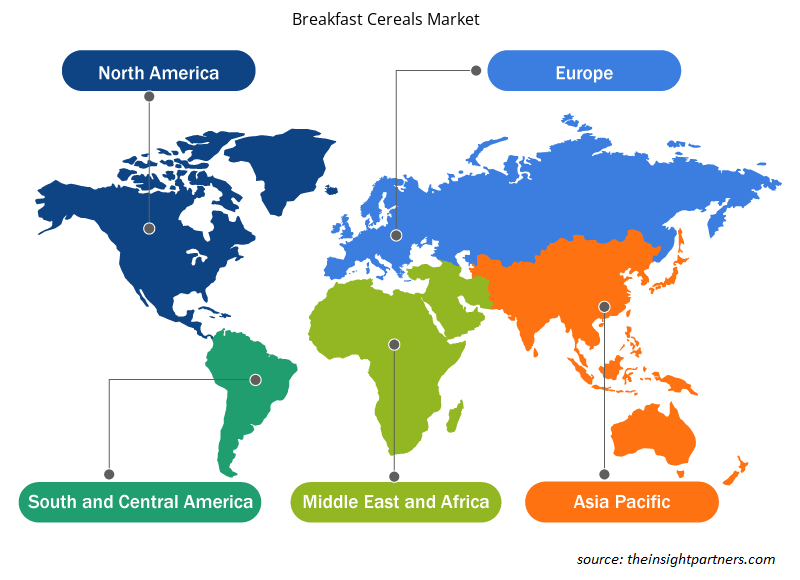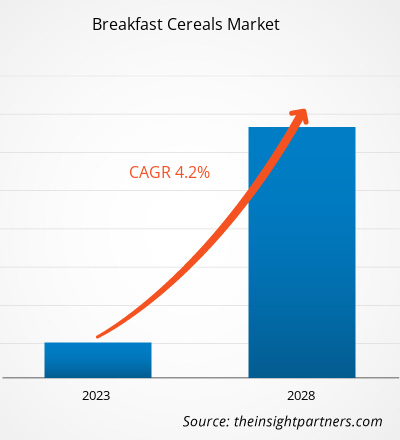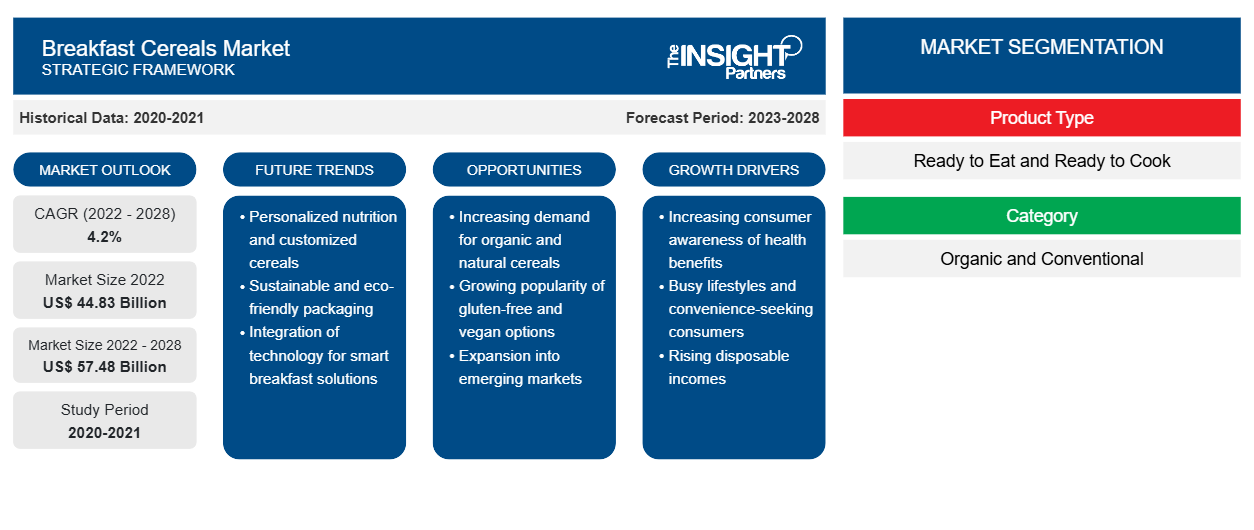Si prevede che il mercato dei cereali per la colazione raggiungerà i 57.482,17 milioni di dollari entro il 2028, rispetto ai 44.831,48 milioni di dollari del 2022. Si prevede che crescerà a un CAGR del 4,2% nel periodo 2022-2028.
La crescita del mercato è attribuita alla rapida crescita della preferenza dei consumatori per i cibi pronti. Oggigiorno, le persone hanno stili di vita e valori sociali diversi, il che alimenta la domanda di cibi pronti. La tecnologia digitale che consente loro di fare la spesa più velocemente ha aumentato la loro dipendenza dai pasti pronti. Questi prodotti sono disponibili in varie varietà e forme, come pasti da microonde, pasti da asporto, noodles in pentola istantanea e altri tipi di pasti, il che ha aumentato la disponibilità di cibo nel Regno Unito. L'aumento del consumo di cibo pronto ha portato i consumatori ad acquistare più pasti pronti nella regione. Tuttavia, a causa dei lockdown causati dall'epidemia di COVID-19, i consumatori hanno fatto ricorso alla cucina a casa, il che ha ostacolato in una certa misura il mercato.
Nel 2021, il Nord America deteneva la quota chiave del mercato globale dei cereali per la colazione . Tuttavia, si stima che l'Asia Pacifica registrerà il CAGR più elevato nel mercato durante il periodo di previsione. Il mercato nell'Asia Pacifica è segmentato in Cina, India, Giappone, Corea del Sud e Australia. I paesi dell'APAC, come Corea del Sud, Cina e Giappone, sono tra i principali mercati di alimenti e bevande. La regione ospita anche numerosi produttori di cereali per la colazione, che stanno crescendo a causa della crescente domanda interna di bevande confezionate. La crescente produzione di bevande nell'Asia Pacifica e la crescente preferenza per gli alimenti pronti al consumo contribuirebbero alla crescita del mercato nella regione durante il periodo di previsione.
Personalizza questo report in base alle tue esigenze
Riceverai la personalizzazione gratuita di qualsiasi report, comprese parti di questo report, o analisi a livello nazionale, pacchetto dati Excel, oltre a usufruire di grandi offerte e sconti per start-up e università
-
Scopri le principali tendenze di mercato in questo rapporto.Questo campione GRATUITO includerà analisi di dati che spaziano dalle tendenze di mercato alle stime e alle previsioni.
Impatto della pandemia di COVID-19 sul mercato dei cereali per la colazione
La pandemia di COVID-19 ha sconvolto in modo significativo il settore manifatturiero in termini di efficienza operativa, a causa di lockdown prolungati in diverse regioni, chiusure di unità produttive, restrizioni sui viaggi, commerci internazionali e filiera di fornitura, e carenze nella fornitura di materie prime, che alla fine hanno ostacolato il mercato dei cereali per la colazione. L'interruzione del settore alimentare e delle bevande dovuta al rallentamento economico causato dall'epidemia ha anche ostacolato la crescita del mercato. Tuttavia, le aziende si sono riprese in quanto le limitazioni precedentemente imposte sono state allentate in vari paesi.lockdowns across different regions, manufacturing unit shutdowns, restrictions on travel, international trades, and supply chain, and shortages in the raw materials supply, which eventually hampered the breakfast cereals market. The disruption of the food & beverages industry due to the economic slowdown caused by the outbreak also hindered the market's growth. However, businesses have recovered thus as previously imposed limitations are being eased across various countries.
Inoltre, l'introduzione dei vaccini COVID-19 da parte dei governi di diversi paesi ha ulteriormente alleviato la situazione, portando a un aumento delle attività commerciali in tutto il mondo. Inoltre, i governi di diversi paesi stanno pianificando di sviluppare infrastrutture moderne e tecnologicamente avanzate per mitigare gli impatti economici della pandemia. Durante il lockdown, i consumatori hanno acquistato molti alimenti e bevande confezionati contemporaneamente anziché articoli di ristorazione. Pertanto, nonostante gli impatti negativi della pandemia di COVID-19, si prevede che il mercato dei cereali per la colazione crescerà in modo significativo nei prossimi anni.lockdown, consumers purchased many packaged foods and beverages at once instead of food service items. Thus, despite the negative impacts of the COVID-19 pandemic, the breakfast cereals market is expected to grow significantly in the coming years.
Approfondimenti di mercato
Crescente consumo di prodotti RTE
I prodotti alimentari pronti al consumo sono diventati uno dei pochi settori che hanno assistito a un'impennata di domanda immensa durante la pandemia di COVID-19. Con i paesi in lockdown e la maggior parte delle persone che lavora da casa, il consumo di prodotti alimentari pronti al consumo è aumentato vertiginosamente. I giovani consumatori spendono la maggior parte del loro reddito in comodi prodotti alimentari pronti al consumo, diventando così il target principale di questi prodotti. Pertanto, la domanda e il consumo crescenti di cibo pronto al consumo stanno guidando il mercato dei cereali per la colazione.lockdown and most people working from home, the consumption of
Approfondimenti sulla categoria
In base alla categoria, il mercato globale dei cereali per la colazione è suddiviso in biologico e convenzionale. Nel 2021, il segmento convenzionale ha rappresentato una quota di mercato maggiore. Tuttavia, si prevede che il segmento biologico aumenterà a un CAGR più elevato durante il periodo di previsione. I consumatori sono diventati più consapevoli dell'importanza di un forte sistema immunitario e di uno stile di vita sano, con conseguente preferenza per alimenti biologici e naturali. Si prevede che il cambiamento di mentalità continuerà a stimolare il mercato degli alimenti biologici durante il periodo di previsione. I prodotti alimentari biologici sono preparati con zero conservanti e non contengono sostanze chimiche sintetiche. Pertanto, le persone stanno accettando prodotti alimentari biologici nella loro dieta, il che aiuterà il mercato a crescere nel periodo di previsione.CAGR during the forecast period. Consumers have become more aware of the importance of a strong immune system and healthy lifestyle, resulting in a preference for organic and natural foods. The shift in mindset is expected to continue to boost the organic food market during the forecast period. Organic food products are prepared with zero preservatives and contain no synthetic chemicals. Therefore, people are accepting organic food products into their diet, which will help the market grow in the forecast period.
The Kellogg Company; WEETABIX; Bob's Red Mill Natural Foods; General Mills Inc.; Nestlé SA; Nature's Path Foods; The Quaker Oats Company; Carman's Fine Foods Pty Ltd.; Calbee, Inc.; e Guilin Seamild Foods Co. Ltd. sono i player che operano nel mercato dei cereali per la colazione. Queste aziende forniscono un'ampia gamma di portafogli di prodotti per il mercato. Le aziende sono presenti nelle regioni in via di sviluppo, il che offre opportunità redditizie per il mercato. I player del mercato stanno sviluppando prodotti innovativi e di alta qualità per soddisfare le esigenze dei clienti.WEETABIX; Bob’s Red Mill Natural Foods; General Mills Inc.; Nestlé SA; Nature's Path Foods; The Quaker Oats Company; Carman's Fine Foods Pty Ltd.; Calbee, Inc.; and Guilin Seamild Foods Co. Ltd. are the players operating in the breakfast cereals market. These companies provide a wide range of product portfolios for the market. The companies have their presence in the developing regions, which provides lucrative opportunities for the market. Market players are developing high-quality, innovative products to meet customer requirements.
Approfondimenti regionali sul mercato dei cereali per la colazione
Le tendenze regionali e i fattori che influenzano il mercato dei cereali per la colazione durante il periodo di previsione sono stati ampiamente spiegati dagli analisti di Insight Partners. Questa sezione discute anche i segmenti e la geografia del mercato dei cereali per la colazione in Nord America, Europa, Asia Pacifico, Medio Oriente e Africa e Sud e Centro America.

- Ottieni i dati specifici regionali per il mercato dei cereali per la colazione
Ambito del rapporto di mercato sui cereali per la colazione
| Attributo del report | Dettagli |
|---|---|
| Dimensioni del mercato nel 2022 | 44,83 miliardi di dollari USA |
| Dimensioni del mercato entro il 2028 | 57,48 miliardi di dollari USA |
| CAGR globale (2022 - 2028) | 4,2% |
| Dati storici | 2020-2021 |
| Periodo di previsione | 2023-2028 |
| Segmenti coperti |
Per tipo di prodotto
|
| Regioni e Paesi coperti |
America del Nord
|
| Leader di mercato e profili aziendali chiave |
|
Densità dei player del mercato dei cereali per la colazione: comprendere il suo impatto sulle dinamiche aziendali
Il mercato dei cereali per la colazione sta crescendo rapidamente, spinto dalla crescente domanda degli utenti finali dovuta a fattori quali l'evoluzione delle preferenze dei consumatori, i progressi tecnologici e una maggiore consapevolezza dei benefici del prodotto. Con l'aumento della domanda, le aziende stanno ampliando la propria offerta, innovando per soddisfare le esigenze dei consumatori e capitalizzando sulle tendenze emergenti, il che alimenta ulteriormente la crescita del mercato.
La densità degli operatori di mercato si riferisce alla distribuzione di aziende o società che operano in un particolare mercato o settore. Indica quanti concorrenti (operatori di mercato) sono presenti in un dato spazio di mercato in relazione alle sue dimensioni o al valore di mercato totale.
Le principali aziende che operano nel mercato dei cereali per la colazione sono:
- La società Kellogg
- WEETABIX
- Bob's Red Mill Cibi naturali
- Società anonima General Mills Inc.
- Nestlé SA
Disclaimer : le aziende elencate sopra non sono classificate secondo un ordine particolare.

- Ottieni una panoramica dei principali attori del mercato dei cereali per la colazione
Segnala i riflettori
- Tendenze industriali progressive nel mercato dei cereali per la colazione per aiutare gli operatori a sviluppare strategie efficaci a lungo termine
- Strategie di crescita aziendale adottate dai mercati sviluppati e in via di sviluppo
- Analisi quantitativa del mercato dei cereali per la colazione dal 2020 al 2028
- Stima della domanda globale di cereali per la colazione
- Analisi delle cinque forze di Porter per illustrare l'efficacia degli acquirenti e dei fornitori che operano nel settore
- Sviluppi recenti per comprendere lo scenario competitivo del mercato
- Tendenze e prospettive di mercato e fattori che guidano e frenano la crescita del mercato dei cereali per la colazione
- Assistenza nel processo decisionale evidenziando le strategie di mercato che sostengono l'interesse commerciale, portando alla crescita del mercato
- La dimensione del mercato dei cereali per la colazione in vari nodi
- Panoramica dettagliata e segmentazione del mercato, nonché dinamiche del settore dei cereali per la colazione
- Dimensioni del mercato dei cereali per la colazione in diverse regioni con promettenti opportunità di crescita
"Global Breakfast Cereals Market Analysis to 2028" è uno studio specializzato e approfondito del settore dei prodotti chimici e dei materiali con un'attenzione particolare all'analisi delle tendenze del mercato globale dei cereali per la colazione. Il rapporto mira a fornire una panoramica del mercato con una segmentazione di mercato dettagliata.
Il mercato dei cereali per la colazione viene analizzato in base a materiale, applicazione e geografia. In base al tipo di prodotto, il mercato è segmentato in pronto da mangiare e pronto da cucinare. In base alla categoria, il mercato è segmentato in biologico e convenzionale. In base al tipo, il mercato è segmentato in basso contenuto di zucchero e normale. In base al canale di distribuzione, il mercato è segmentato in supermercati e ipermercati, minimarket, vendita al dettaglio online e altri. In base alla geografia, il mercato è ampiamente segmentato in Nord America, Europa, Asia Pacifico (APAC), Medio Oriente e Africa (MEA) e Sud e Centro America.
Profili aziendali
- La società Kellogg
- WEETABIX
- Bob's Red Mill Cibi naturali
- Società anonima General Mills Inc.
- Nestlé SA
- Cibo del percorso della natura
- La Quaker Oats Company
- Azienda Agricola Carman's Fine Foods Pty Ltd.
- Calbee, Inc.
- Azienda alimentare Guilin Seamild Foods Co. Ltd.
- Analisi storica (2 anni), anno base, previsione (7 anni) con CAGR
- Analisi PEST e SWOT
- Valore/volume delle dimensioni del mercato - Globale, Regionale, Nazionale
- Industria e panorama competitivo
- Set di dati Excel
Report recenti
Testimonianze
Motivo dell'acquisto
- Processo decisionale informato
- Comprensione delle dinamiche di mercato
- Analisi competitiva
- Analisi dei clienti
- Previsioni di mercato
- Mitigazione del rischio
- Pianificazione strategica
- Giustificazione degli investimenti
- Identificazione dei mercati emergenti
- Miglioramento delle strategie di marketing
- Aumento dell'efficienza operativa
- Allineamento alle tendenze normative























 Ottieni un campione gratuito per - Mercato dei cereali per la colazione
Ottieni un campione gratuito per - Mercato dei cereali per la colazione